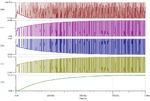samy555
Full Member level 4
Hello
From: **broken link removed**
I read all the page and have some questions and hope someone (like Jony130) respond
Q1) Can someone give values for the circuit below as it is,,, I know it is a basic circuit but I want to build it and see some waveforms on my new oscilloscope.
This current will maintain the Q1 always ON. How Q1 be OFF in other period of time?
Tomorrow I will put more questions
Thank you
From: **broken link removed**
I read all the page and have some questions and hope someone (like Jony130) respond
Q1) Can someone give values for the circuit below as it is,,, I know it is a basic circuit but I want to build it and see some waveforms on my new oscilloscope.
**broken link removed**
Q2) If Rs = 100Kohm and VCC = 12Vdc then IB = about 113uAThis current will maintain the Q1 always ON. How Q1 be OFF in other period of time?
Tomorrow I will put more questions
Thank you


